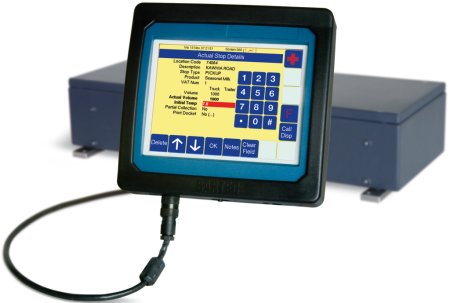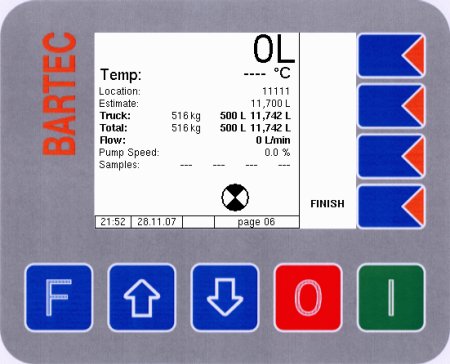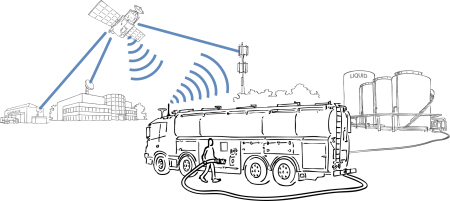Tux delivers fresh milk in Germany
Dec 12, 2007 — by Eric Brown — from the LinuxDevices Archive — 3 views Two German firms have collaborated on a Linux-based logistics system for tanker transport of liquid goods, such as milk. The System 3003 system is comprised of Emlix GmbH's in-cabin subsystem (ICS) for driver guidance and BARTEC GmbH's and metering-sampling subsystem (MSS), which monitors liquid… delivery/collection.
Two German firms have collaborated on a Linux-based logistics system for tanker transport of liquid goods, such as milk. The System 3003 system is comprised of Emlix GmbH's in-cabin subsystem (ICS) for driver guidance and BARTEC GmbH's and metering-sampling subsystem (MSS), which monitors liquid… delivery/collection.
digg this story |
The GPS-enabled system closely integrates the ICS and MSS via an Ethernet network on the truck, communicating back to its dairy customers' ERP (enterprise resource planning) systems via GPRS. BARTEC GmbH, which develops a variety of liquid-collection systems, is selling the jointly developed system to the dairy industry, but there are possibilities of using the underlying technology for other liquid collection applications.

System 3003 ICS unit
(Click to enlarge)
Tanker drivers interact with the ICS via a Java-based mapping application. The computer is linked via GPRS (as well as a back-up radio) to an office-based scheduling and dispatch desktop application supplied by the customer. The central office application is used to schedule tanker routes, downloading shift and route data to the ICS via XML files.
The ICS periodically fixes the truck's location via GPS, and communicates the position to the office application. Also communicated are “TAMS” (tanker activity monitoring system) data such as vehicle condition and the driver's behavior, which are derived by sampling the vehicle's onboard computer via a CAN (controller area network) bus tap. In an accident, a distress signal is transmitted back to headquarters along with a log of TAMS data, Emlix says.
The ICS also uses GPS to recognize when the truck arrives at a planned collection point. The device then displays the type and amount of liquid product to be collected while simultaneously informing the linked MSS unit, which is attached to the truck's collection equipment.

System 3003's MSS unit screenshot
(Click to enlarge)
The rack-based MSS system monitors the collection process through a variety of sensors. Supported sensor cards include basic valve control, pump speed control, flow meter, and temperature probe. Other sensors, including filling level sensors, can be connected via USB or RS232, says Emlix. The MSS is also equipped with RFID-based identification of the trailer and of farm/factory connection points.

Conceptual diagram of Bartec System 2003 system for milk collection
Both the ICS and MSS are equipped with PPC 8280 processors, 128-256MB RAM, 64MB internal Flash, and a 256-512MB Compact Flash drive. Both systems include Ethernet ports and a SM501-based graphics card to control their 640×480 touchscreen TFT displays. In addition, the ICS includes a GPS receiver and GPRS modem. The units are said to operate in temperatures between -20 to +60°C.
The System 3003's software core is designed to enable cooperative multitasking, says Emlix, dynamically loading the application modules, which are allowed to communicate with each other without restrictions. This framework “enables multiple instances on different computers to be interconnected transparently via TCP/IP, thus creating the impression of a single large system,” says the company. The software is said to include remote software version management/deployment and a human-machine interface (HMI) with screen layout specification delivered via XML.
The System 3003's software is based on a Linux 2.4.25 kernel, modified to include additional device drivers. Other open source software used in the development of the system is said to include:
- Base System tools — busybox, coreutils, expat, e2fsprogs, etc.
- Background services — cron, syslog-ng, logrotate, etc.
- Databases — sqlite3
- Scripting support — LUA, python, PHP
- Connectivity — telnet, openssh, pppd, thttpd, etc.
This article was originally published on LinuxDevices.com and has been donated to the open source community by QuinStreet Inc. Please visit LinuxToday.com for up-to-date news and articles about Linux and open source.